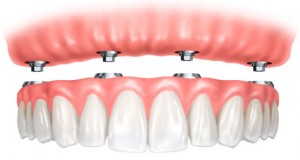
With all-on-fours, only eight dental implants can replace all of a patient’s teeth. All of the teeth in either the upper or lower jaw, is replaced by only four implants.
All on fours are typically used for patients looking to replace a full set of teeth. The procedure has been tested and improved much since dentists started performing it in the 1970’s. With all the developments made, all-on-fours have become a highly successful means of tooth replacement. With a lowered cost and lifelong satisfaction, the option is considered both accessible and reliable.
How Does It Work?
With all-on-fours, only eight dental implants can replace all of a patient’s teeth. The name is derived from the fact that an arch of teeth, meaning all of the teeth in either the upper or lower jaw, is replaced by only four implants.
What makes the procedure even more accessible to many patients, is that bone grafting isn’t necessary (even in patients with decreased jawbone density). This is because all-on-fours are specifically implanted into areas of the jaw that typically have a higher bone density. By placing the implant at an optimal angle, dentists efficiently use the available bone tissues.

All-on-4s attach fasten to the abutment of the dental implant
Bone grafting procedures can be both inconvenient and costly. Avoiding them makes the procedure more financially attainable for a larger group of patients.
All-on-Four Patients
Most patients choosing to have a full arch of teeth replaced are either completely edentulous (without any teeth), or are suffering from failing dentition (teeth are falling out, breaking irreparably or damaged extensively). For patients that still have teeth, any remaining teeth will need to be extracted before the procedure can be performed.
Many might wonder whether or not the procedure is a good option for patients who have been wearing dentures. Patients who wear dentures are well aware of the limitations associated with unsupported, removable teeth. Because of this, many seek an alternative. These patients are often good candidates for the all-on-four procedure.
Patients suffering from osteoporosis who wish to replace dentures with all-on-four implants should pay special attention to the health of their bone tissue. Wearing dentures can accelerate deterioration of bone tissue in the jaw. Left too long, bone tissues can become too weak to support even all-on-four implants, which would necessitate bone grafting. The good thing about dental implants is that they stimulate bone growth rather than accelerating bone loss.
Any patient considering all-on-four implants will need to visit their dentist. This is the only way patients can know for certain whether or not they’ll be good candidates for the procedure.
Treatment Time
 Because the use of all-on-four implants aims to avoid bone grafting, the procedure is certainly the fastest way to replace missing teeth using dental implants.
Because the use of all-on-four implants aims to avoid bone grafting, the procedure is certainly the fastest way to replace missing teeth using dental implants.
With traditional implants, patients can wait many months to replace even a single tooth. This is because the bone tissue has to be prepared for the implant. Treatment is completed in phases in order to allow adequate bone growth from one phase to the next.
However, all-on-fours are specially placed in areas of the jaw that have enough bone tissue to support the new teeth. Patients won’t have to wait for bone tissue to grow after bone grafting or implant surgery. Once a patient goes in for surgery, the entire procedure is completed in a single day.
A Prosthodontics Procedure
The placement of all-on-four implants is considered a prosthodontic procedure. Prosthodontics, also referred to as prosthetic dentistry or dental prosthetics, is a branch of dentistry concerned with the use of dental prostheses for the restoration and replacement of teeth. Prosthodontics is one of nine dental specialties recognized by the American Dental Association (ADA). Prosthodontic specialists are called prosthodontists.
Dentists who wish to become prosthodontists are required to complete an additional three to four years of training. During this time, special emphasis is placed on the surgical placement of dental implants, as prosthodontists are expected to be highly competent in this area.

Dr. John C. Stone, Prosthodontist
Other procedures often performed by prosthodontists include:
• Veneer placement
• Tooth restoration using dental inlays and onlays
• Tooth restoration using dental caps
• Fitting patients with either regular or supported dentures
• Placing mini dental implants
Dr. Stone regularly performs dental implant surgery at his practice in Fort Lauderdale. He’s been a prosthodontist for more than thirty years. Dr. Stone’s practice also boasts an on-site laboratory, helping patients save both time and money. When Dr. Stone isn’t doing patient work, he teaches dental implant techniques at two nearby colleges.
Apart from prosthodontics work, Dr. Stone also takes in patients with regular dental emergencies. There are few things as bad as a severe toothache, which is why patients with emergencies are seen on the same day whenever possible.


